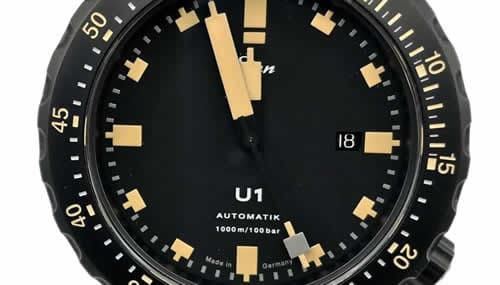
Ultimate Guide to Watch Water Resistance (Bar, Meters & More!)
It’s safe to say that whether you’re a seasoned collector who knows a tourbillon from a tachymeter or a curious novice dipping your toes into the world of timepieces, one factor defines every one of us – the water resistance of your watch.
In this guide, I’ll take you into the varied depths of watch water resistance, deciphering the cryptic codes of bars, meters, and atmospheres that grace the spec sheet of almost every watch ever made. From the humble drizzles to the abyssal depths, I’ll unravel the enigmatic language of water resistance ratings.
As we make our way through this guide, you’ll unearth the secrets behind ensuring your watch meets every drop of water with panache and, in doing so, will come to understand why and how a timepiece stays dry against all odds. So, fasten your straps and join me in exploring the depths of horological durability – where precision meets the unpredictable waters of life.
Built For Pressure – About Watch Water Resistance
For those of you who can, cast your minds back to the early 1920s, a pivotal epoch when watchmaking wizards conjured the first water-resistant timepieces. These groundbreaking tickers defied the drenching forces of nature, gifting us a new realm of durability and propelling the practical application of watches to new heights.
Imagine the audacity it took to craft a watch that remained unaffected by splashes and showers, a concept that would evolve into the meticulously calibrated depth ratings we encounter today.
The pioneers were Swiss, naturally, paving the path for a sea change in watchmaking standards. Fast forward through the tides of time, and we find ourselves dealing with an altogether more complex rendering of water resistance, creating and buying watches capable of far more than withstanding a spot of rain.
So, let’s dive into the origins of watch water resistance and how it transformed our wrist companions into formidable aquatic companions.
Dryness in The Depths – Why Is Watch Water Resistance Important?
For every aficionado, understanding the nuances of varying water resistance levels isn’t just a whimsical dalliance; it’s a compass guiding you through a sea of potential mishaps. If I had a dollar for every time a friend took their 30m-proofed watch into adverse water-sport conditions, I’d have about 7 dollars.
Ideas of pressure and depth tend to be a tad misleading at face value – if it says 50m, you should be able to take it down to 50m, right? If only it were that simple.
Water resistance is about counteracting the outside pressures that seek to force water into your wonderfully dry watch case, and thus, it’s a very important factor for any timepiece.
Knowing your watch’s aquatic acumen isn’t just about flaunting knowledge; it’s about making informed choices. Choosing the right timepiece for the right adventure, be it a daring dive or a drizzly afternoon, is an ode to preservation. The wrist deserves nothing less than a companion tailored to its aquatic ambitions.
In this horological journey, clarity on bars, meters, and atmospheres isn’t mere numerical trivia – it’s the fortress protecting your precious investment from a watery grave. So don’t just skim these waters; delve deep. Equip yourself with the wisdom to match your watch to the environment, ensuring your cherished timepiece doesn’t suffer a soggy, sad fate.
Water Resistance At A Glance
To keep you afloat amidst the sea of specifications, here’s a handy table that sums up the depths your timepiece might be able to handle. Remember, these numbers aren’t just digits; they’re specific directives to ensure that your watch is never in troubled waters unless that’s what it’s built for. Dive in wisely!
Remember, fellow enthusiasts, water resistance isn’t just about bragging rights—it’s about matching your watch’s capabilities to your aquatic escapades. So consult this table before buying that new Omega and taking it to the islands for some salt and sand.
Watch Water Resistance: In-Depth Guide
Brace yourselves, fellow horology explorers, as we navigate the aquatic labyrinth of bars, meters, and atmospheres to ensure your beloved timepiece stays afloat in style.
3 Bar (30m / 100ft / 3 ATM)
Only the most gentle drizzles and accidental splashes will concede to this level of resistance. Think of it as your watch’s umbrella against unexpected weather tantrums. A 3 bar rating is usually found on dress watches and more elegant timepieces, which are suitable for everyday wear but not necessarily the type of ticker that you’d take into the water with you. Have you ever seen a dress Calatrava on a surfer’s wrist?
5 Bar (50m / 165ft / 5 ATM)
Slightly bolder, the 50m rating welcomes impromptu rain dances and quick hand washes. However, snorkeling enthusiasts beware – this isn’t yet your ideal aquatic partner. Found in an array of watches, from sports to fashion, this level of resistance will enable everyday escapades, albeit with caution, near open bodies of water.
10 Bar (100m / 330ft / 10 ATM)
Meet the adventurous soul of water resistance. Ideal for swimming and snorkeling, 100m stalwarts often grace sports watches with their protective prowess. But the abyss remains off-limits. Consider a watch with this level of resistance a reliable companion for onshore activities and more vanilla splashes in the shallows. As a rule of thumb, you can take a 100m-rated watch down just as deep as a single breath hold allows.
20 Bar (200m / 660ft / 20 ATM)
This is the business end of water resistance, where most entry-level dive watches and sports watches shine in aqueous situations. With hearty resistance, a watch with this resistance will make a splash among scuba aficionados and water sports enthusiasts. Perfect for recreational diving and heavy water sports, with a rating of 200m, it’s likely you’ll never worry about a leak.
30 Bar (300m / 990ft / 30 ATM) & More
Behold, the conquerors of oceanic depths! Preferred by professional divers and aquatic adventurers, these watches defy the crushing pressures that exist at the most challenging depths. Beyond the sea, they exhibit a rugged charm fit for audacious souls, defined by tool-centric builds and ultra-durable materials. If you’ve got 300m or more on your watch face, you’re likely very serious about diving.
So, as you don your chosen wrist companion, ensure its aquatic aspirations match those of your adventures. With this guide in mind, you’re equipped to navigate the waves and make a splash without compromising your cherished timepiece.
What Is The Highest Watch Water Resistance?
Prepare to be amazed as we plunge into the depths of the watch world’s ultimate aquatic marvel – the Rolex Deepsea Challenge. With a water resistance rating that plunges to a staggering 11,000 meters, this timekeeping titan raises the bar beyond imagination. Indeed, it raises it well beyond human capability – no one would ever live to tell the tale of an adventure down to 12,000 meters.
Their Rolex would, though. A wrist-worn vessel of exploration, the Deepsea Challenge boasts a pressure-defying design that can withstand the crushing forces of the earth’s deepest point, the Mariana Trench.
But Rolex isn’t the only player in this watery arena. Brands like Omega and Seiko have also made efforts to conquer the abyss, crafting watches that challenge the very notion of water resistance. Omega’s Seamaster Ploprof, with its 1,200-meter resistance, showcases Swiss engineering prowess, while Seiko’s Prospex Marinemaster holds its ground with remarkable depth ratings.
In a world where the depths remain a tantalizing (if not downright scary) frontier, these watches not only celebrate human ingenuity but also highlight the indomitable spirit of horology. So, whether you’re scaling the oceans or simply reveling in some awe-inspiring engineering, these watches prove that the depths of human ambition are as limitless as the sea itself.
How To Maintain Your Watch Water Resistance
If you’ve made it this far into the article, it’s important to you to ensure your cherished timepieces remain water-resistant fortresses. What you now know is that certain depth ratings correspond with certain activities. What you may not know yet is that there are ways to maintain the effectiveness of your watch’s water resistance.
Regular Servicing
Much like a ship requires maintenance before a voyage, your watch yearns for periodic servicing. Entrust your timepiece to a skilled (and licensed) watchmaker for sealing inspections, gasket replacements, and pressure tests. A well-maintained seal ensures your watch’s resistance remains as steadfast as possible.
The Wrist Ritual – Proper Crown Handling
Explore the
Biggest Pre-Owned Collection of Luxury Watches
The crown is your watch’s gateway to precise timekeeping, but it’s also any ticker’s greatest vulnerability when water is concerned. Whenever you’re not altering the time or date, ensure the crown is tightly pushed in. Think of it as securing hatches on a ship; a loose crown exposes your watch’s mechanisms to unwelcome moisture.
Rinse and Pat Dry
After frolicking in aquatic escapades, give your watch a gentle rinse with fresh water. But remember, no high-pressure hoses; we’re not launching torpedoes. Once bathed, pat your watch dry with a soft cloth. An ocean of caution: Never use a hairdryer or direct sunlight—they’re treacherous impediments to the longevity of your timepiece’s water resistance.
Avoid Extreme Shifts
Imagine subjecting your watch to Arctic chills and then plunging into a thermal spring—quite the stress test! Avoid exposing your watch to extreme temperature changes, as sudden shifts can compromise its seals, which contract and expand under varying pressures, just like everything else. Whether you’re braving blizzards or basking in sun rays, gradual transitions are pivotal for the safety of your watch.
Straps and Sealing
A watch is only as water-resistant as its weakest link, and that includes straps. Ensure the strap or bracelet is properly attached and doesn’t compromise the case’s seals. Rubber, silicone, and NATO straps are reliable shipmates when sailing the waters, more than metal bracelets.
With these maritime rules in your horological arsenal, you’ll be the captain of a shipshape timekeeper. As you explore beneath the waves, remember that maintaining your watch’s water resistance is akin to steering through life’s unpredictable tides – do it responsibly and with panache.
Conclusion
As we lower the anchor on this horological expedition, remember that understanding watch water resistance is more than deciphering numbers – it’s a voyage of preserving precision in the face of aqueous challenges. So, next time you’re caught in a rainstorm or contemplating a dive, let this guide be your compass.
With knowledge as your first mate, your timepiece will not only weather the waters but triumphantly navigate them. May your watches stay ever-resilient and your journeys, both on land and beneath the waves, be punctuated by the unwavering reliability of a well-chosen, water-ready timepiece.
About Exquisite Timepieces
Established in 1998, Exquisite Timepieces is your one-stop shop for all things luxury watches! We are an authorized dealer for 60+ luxury watch brands including Omega, Hublot, Seiko, & Longines! We are proud to showcase one of the world’s largest pre-owned watch collections, including renowned brands like Rolex and Patek Philippe. Check out our brand new watch arrivals here and popular pre-owned listings here.




















